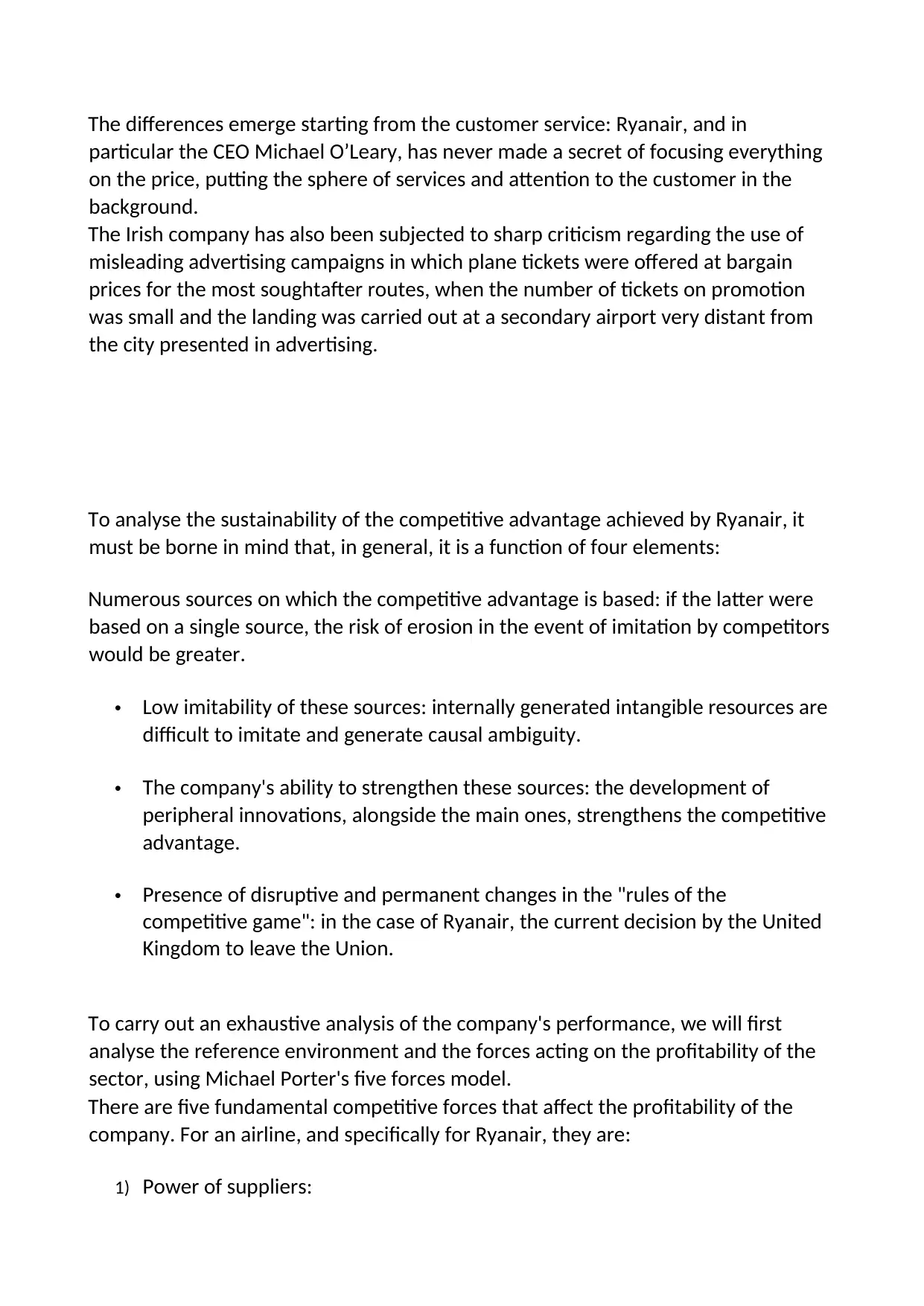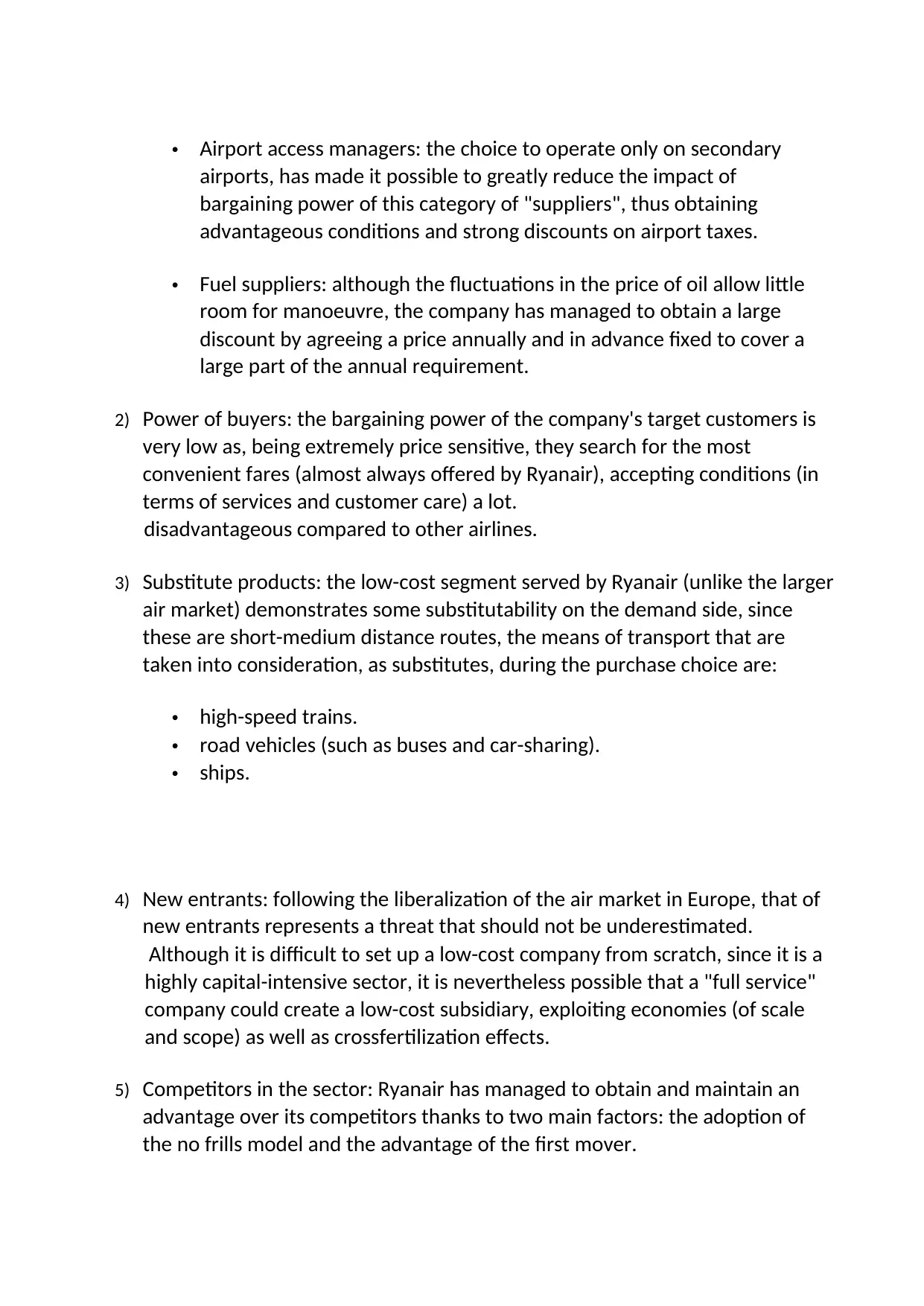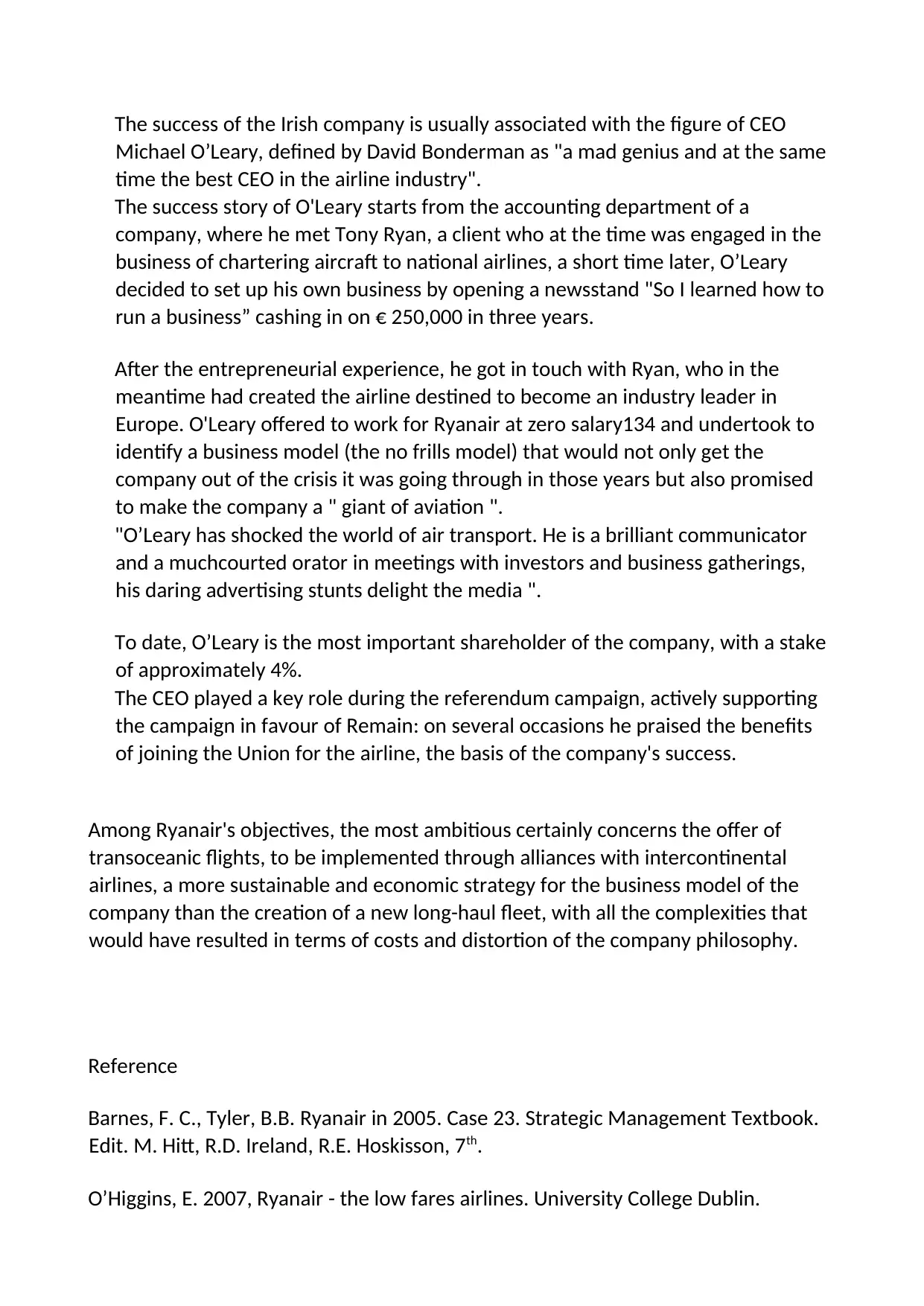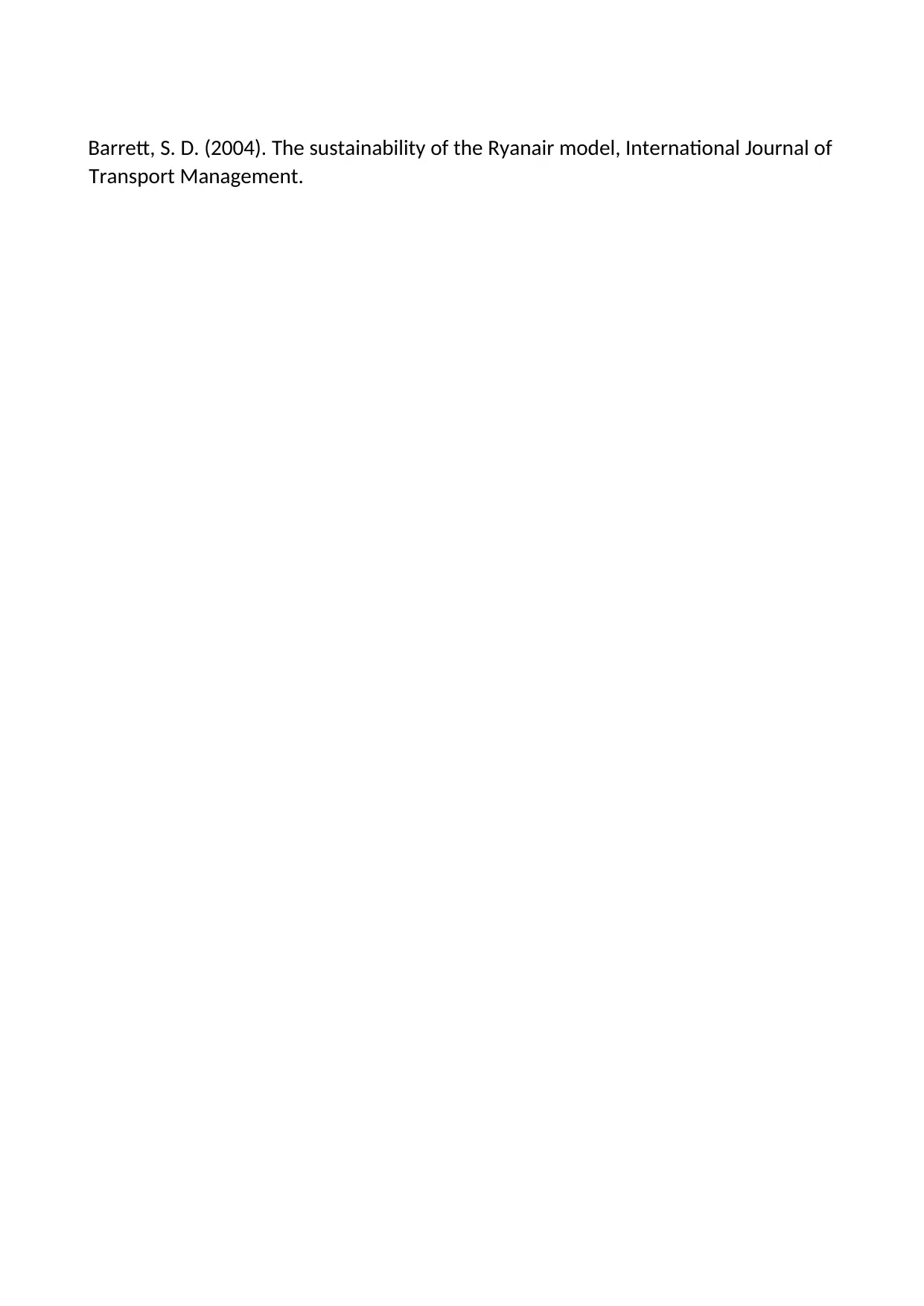RYANAIR CASE. To Analyse the Low Fares Model
VerifiedAdded on 2022/04/20
|6
|1787
|29
AI Summary
Ryanair's low fares concept was created to encourage demand from tourists and young people who would otherwise take other modes of transportation or not travel at all.
Contribute Materials
Your contribution can guide someone’s learning journey. Share your
documents today.

RYANAIR CASE
To analyse the low fares model adopted by Ryanair, it is necessary to start by
identifying the company's target market:
"Ryanair's low fares concept was designed to stimulate demand in particular from
tourists and young people who otherwise would have used other means of
transport or would not have travelled at all"
The positioning of the company therefore seems to be very targeted: the reference
market is made up of those who would be willing to take advantage of alternative
means of transport to the plane if not enticed by particularly advantageous rates.
It is therefore a volume driven market, with a very elastic demand with respect to
price. The adoption of the low fares model is therefore functional to the satisfaction
of the client-target of the company which, being "budget conscious" is willing to
give up some of the services offered by traditional "full service" airlines, to obtain
advantageous fares.
It is the CEO himself, Michael O'Leary, who firmly affirms that Ryanair does not seek
its competitors among the large flag carriers, as these serve a target of customers
with very different needs, who seek a certain level of customer care. and
demonstrates lower price sensitivity: “We promise to give you the cheapest rate.
You have a safe flight. You have a flight usually on time, this is the package.
We do not give you and we will not give you anything else. We think about our
customers in the most fundamental way: we don't peel them every time we fly
them. I don't want to have anything to do with those big airlines that say they think
about their customers and then pay you six or seven hundred pounds every time
you fly ".
Ryanair's therefore appears to be a focus strategy based on cost leadership, which
identifies as its objective a specific market segment characterized by a target
clientele made up of tourists, young people and, in general, those who show greater
sensitivity to price rather than to complementary services.
To be able to offer highly competitive rates and at the same time obtain good profit
margins, the top management directs its efforts in the implementation of an
efficiency policy and attention to costs, contributing to the success of the Irish
company's strategy is the advantage of the first mover, having been the first in
Europe to use a low-fares business model.
To analyse the low fares model adopted by Ryanair, it is necessary to start by
identifying the company's target market:
"Ryanair's low fares concept was designed to stimulate demand in particular from
tourists and young people who otherwise would have used other means of
transport or would not have travelled at all"
The positioning of the company therefore seems to be very targeted: the reference
market is made up of those who would be willing to take advantage of alternative
means of transport to the plane if not enticed by particularly advantageous rates.
It is therefore a volume driven market, with a very elastic demand with respect to
price. The adoption of the low fares model is therefore functional to the satisfaction
of the client-target of the company which, being "budget conscious" is willing to
give up some of the services offered by traditional "full service" airlines, to obtain
advantageous fares.
It is the CEO himself, Michael O'Leary, who firmly affirms that Ryanair does not seek
its competitors among the large flag carriers, as these serve a target of customers
with very different needs, who seek a certain level of customer care. and
demonstrates lower price sensitivity: “We promise to give you the cheapest rate.
You have a safe flight. You have a flight usually on time, this is the package.
We do not give you and we will not give you anything else. We think about our
customers in the most fundamental way: we don't peel them every time we fly
them. I don't want to have anything to do with those big airlines that say they think
about their customers and then pay you six or seven hundred pounds every time
you fly ".
Ryanair's therefore appears to be a focus strategy based on cost leadership, which
identifies as its objective a specific market segment characterized by a target
clientele made up of tourists, young people and, in general, those who show greater
sensitivity to price rather than to complementary services.
To be able to offer highly competitive rates and at the same time obtain good profit
margins, the top management directs its efforts in the implementation of an
efficiency policy and attention to costs, contributing to the success of the Irish
company's strategy is the advantage of the first mover, having been the first in
Europe to use a low-fares business model.
Secure Best Marks with AI Grader
Need help grading? Try our AI Grader for instant feedback on your assignments.

The differences emerge starting from the customer service: Ryanair, and in
particular the CEO Michael O’Leary, has never made a secret of focusing everything
on the price, putting the sphere of services and attention to the customer in the
background.
The Irish company has also been subjected to sharp criticism regarding the use of
misleading advertising campaigns in which plane tickets were offered at bargain
prices for the most soughtafter routes, when the number of tickets on promotion
was small and the landing was carried out at a secondary airport very distant from
the city presented in advertising.
To analyse the sustainability of the competitive advantage achieved by Ryanair, it
must be borne in mind that, in general, it is a function of four elements:
Numerous sources on which the competitive advantage is based: if the latter were
based on a single source, the risk of erosion in the event of imitation by competitors
would be greater.
• Low imitability of these sources: internally generated intangible resources are
difficult to imitate and generate causal ambiguity.
• The company's ability to strengthen these sources: the development of
peripheral innovations, alongside the main ones, strengthens the competitive
advantage.
• Presence of disruptive and permanent changes in the "rules of the
competitive game": in the case of Ryanair, the current decision by the United
Kingdom to leave the Union.
To carry out an exhaustive analysis of the company's performance, we will first
analyse the reference environment and the forces acting on the profitability of the
sector, using Michael Porter's five forces model.
There are five fundamental competitive forces that affect the profitability of the
company. For an airline, and specifically for Ryanair, they are:
1) Power of suppliers:
particular the CEO Michael O’Leary, has never made a secret of focusing everything
on the price, putting the sphere of services and attention to the customer in the
background.
The Irish company has also been subjected to sharp criticism regarding the use of
misleading advertising campaigns in which plane tickets were offered at bargain
prices for the most soughtafter routes, when the number of tickets on promotion
was small and the landing was carried out at a secondary airport very distant from
the city presented in advertising.
To analyse the sustainability of the competitive advantage achieved by Ryanair, it
must be borne in mind that, in general, it is a function of four elements:
Numerous sources on which the competitive advantage is based: if the latter were
based on a single source, the risk of erosion in the event of imitation by competitors
would be greater.
• Low imitability of these sources: internally generated intangible resources are
difficult to imitate and generate causal ambiguity.
• The company's ability to strengthen these sources: the development of
peripheral innovations, alongside the main ones, strengthens the competitive
advantage.
• Presence of disruptive and permanent changes in the "rules of the
competitive game": in the case of Ryanair, the current decision by the United
Kingdom to leave the Union.
To carry out an exhaustive analysis of the company's performance, we will first
analyse the reference environment and the forces acting on the profitability of the
sector, using Michael Porter's five forces model.
There are five fundamental competitive forces that affect the profitability of the
company. For an airline, and specifically for Ryanair, they are:
1) Power of suppliers:

• Airport access managers: the choice to operate only on secondary
airports, has made it possible to greatly reduce the impact of
bargaining power of this category of "suppliers", thus obtaining
advantageous conditions and strong discounts on airport taxes.
• Fuel suppliers: although the fluctuations in the price of oil allow little
room for manoeuvre, the company has managed to obtain a large
discount by agreeing a price annually and in advance fixed to cover a
large part of the annual requirement.
2) Power of buyers: the bargaining power of the company's target customers is
very low as, being extremely price sensitive, they search for the most
convenient fares (almost always offered by Ryanair), accepting conditions (in
terms of services and customer care) a lot.
disadvantageous compared to other airlines.
3) Substitute products: the low-cost segment served by Ryanair (unlike the larger
air market) demonstrates some substitutability on the demand side, since
these are short-medium distance routes, the means of transport that are
taken into consideration, as substitutes, during the purchase choice are:
• high-speed trains.
• road vehicles (such as buses and car-sharing).
• ships.
4) New entrants: following the liberalization of the air market in Europe, that of
new entrants represents a threat that should not be underestimated.
Although it is difficult to set up a low-cost company from scratch, since it is a
highly capital-intensive sector, it is nevertheless possible that a "full service"
company could create a low-cost subsidiary, exploiting economies (of scale
and scope) as well as crossfertilization effects.
5) Competitors in the sector: Ryanair has managed to obtain and maintain an
advantage over its competitors thanks to two main factors: the adoption of
the no frills model and the advantage of the first mover.
airports, has made it possible to greatly reduce the impact of
bargaining power of this category of "suppliers", thus obtaining
advantageous conditions and strong discounts on airport taxes.
• Fuel suppliers: although the fluctuations in the price of oil allow little
room for manoeuvre, the company has managed to obtain a large
discount by agreeing a price annually and in advance fixed to cover a
large part of the annual requirement.
2) Power of buyers: the bargaining power of the company's target customers is
very low as, being extremely price sensitive, they search for the most
convenient fares (almost always offered by Ryanair), accepting conditions (in
terms of services and customer care) a lot.
disadvantageous compared to other airlines.
3) Substitute products: the low-cost segment served by Ryanair (unlike the larger
air market) demonstrates some substitutability on the demand side, since
these are short-medium distance routes, the means of transport that are
taken into consideration, as substitutes, during the purchase choice are:
• high-speed trains.
• road vehicles (such as buses and car-sharing).
• ships.
4) New entrants: following the liberalization of the air market in Europe, that of
new entrants represents a threat that should not be underestimated.
Although it is difficult to set up a low-cost company from scratch, since it is a
highly capital-intensive sector, it is nevertheless possible that a "full service"
company could create a low-cost subsidiary, exploiting economies (of scale
and scope) as well as crossfertilization effects.
5) Competitors in the sector: Ryanair has managed to obtain and maintain an
advantage over its competitors thanks to two main factors: the adoption of
the no frills model and the advantage of the first mover.

Today it is committed to consolidating the advantage achieved by taking care
to offer the lowest rates on the market, often offering timed offers with very
advantageous discounts.
The core competencies on which Ryanair's competitive advantage is based can be
divided into two main categories:
1) Management:
• Efficiency in core business (air transport), thanks to uniformity of the routes
offered (in terms of length of the routes and type of airports served) and of
the fleet. This allowed for a significant reduction in turnaround times which in
turn allowed for an increase in the number of daily flights.
• Low-cost marketing: Ryanair adopts technological innovations both at the
infrastructural level, such as the use of low-consumption aircraft, and at the
service level, such as the exclusive online booking.
• Brand enhancement: although the subject of numerous criticisms, Ryanair has
established itself in the eyes of customers as the cheapest and most
advantageous airline.
2) Strategic managerial:
• Ability of the top management, of the CEO Micheal O’Leary, to identify and
implement a winning business model and a strategy consistent with the
chosen positioning objective.
• Fleet quality: Boeing 737s consume less fuel than other models, are spacious
and reliable.
• Few administrative offices: in line with the cost reduction policy, the company
has reduced the number and size of offices throughout the territory.
to offer the lowest rates on the market, often offering timed offers with very
advantageous discounts.
The core competencies on which Ryanair's competitive advantage is based can be
divided into two main categories:
1) Management:
• Efficiency in core business (air transport), thanks to uniformity of the routes
offered (in terms of length of the routes and type of airports served) and of
the fleet. This allowed for a significant reduction in turnaround times which in
turn allowed for an increase in the number of daily flights.
• Low-cost marketing: Ryanair adopts technological innovations both at the
infrastructural level, such as the use of low-consumption aircraft, and at the
service level, such as the exclusive online booking.
• Brand enhancement: although the subject of numerous criticisms, Ryanair has
established itself in the eyes of customers as the cheapest and most
advantageous airline.
2) Strategic managerial:
• Ability of the top management, of the CEO Micheal O’Leary, to identify and
implement a winning business model and a strategy consistent with the
chosen positioning objective.
• Fleet quality: Boeing 737s consume less fuel than other models, are spacious
and reliable.
• Few administrative offices: in line with the cost reduction policy, the company
has reduced the number and size of offices throughout the territory.
Secure Best Marks with AI Grader
Need help grading? Try our AI Grader for instant feedback on your assignments.

The success of the Irish company is usually associated with the figure of CEO
Michael O’Leary, defined by David Bonderman as "a mad genius and at the same
time the best CEO in the airline industry".
The success story of O'Leary starts from the accounting department of a
company, where he met Tony Ryan, a client who at the time was engaged in the
business of chartering aircraft to national airlines, a short time later, O’Leary
decided to set up his own business by opening a newsstand "So I learned how to
run a business” cashing in on € 250,000 in three years.
After the entrepreneurial experience, he got in touch with Ryan, who in the
meantime had created the airline destined to become an industry leader in
Europe. O'Leary offered to work for Ryanair at zero salary134 and undertook to
identify a business model (the no frills model) that would not only get the
company out of the crisis it was going through in those years but also promised
to make the company a " giant of aviation ".
"O’Leary has shocked the world of air transport. He is a brilliant communicator
and a muchcourted orator in meetings with investors and business gatherings,
his daring advertising stunts delight the media ".
To date, O’Leary is the most important shareholder of the company, with a stake
of approximately 4%.
The CEO played a key role during the referendum campaign, actively supporting
the campaign in favour of Remain: on several occasions he praised the benefits
of joining the Union for the airline, the basis of the company's success.
Among Ryanair's objectives, the most ambitious certainly concerns the offer of
transoceanic flights, to be implemented through alliances with intercontinental
airlines, a more sustainable and economic strategy for the business model of the
company than the creation of a new long-haul fleet, with all the complexities that
would have resulted in terms of costs and distortion of the company philosophy.
Reference
Barnes, F. C., Tyler, B.B. Ryanair in 2005. Case 23. Strategic Management Textbook.
Edit. M. Hitt, R.D. Ireland, R.E. Hoskisson, 7th.
O’Higgins, E. 2007, Ryanair - the low fares airlines. University College Dublin.
Michael O’Leary, defined by David Bonderman as "a mad genius and at the same
time the best CEO in the airline industry".
The success story of O'Leary starts from the accounting department of a
company, where he met Tony Ryan, a client who at the time was engaged in the
business of chartering aircraft to national airlines, a short time later, O’Leary
decided to set up his own business by opening a newsstand "So I learned how to
run a business” cashing in on € 250,000 in three years.
After the entrepreneurial experience, he got in touch with Ryan, who in the
meantime had created the airline destined to become an industry leader in
Europe. O'Leary offered to work for Ryanair at zero salary134 and undertook to
identify a business model (the no frills model) that would not only get the
company out of the crisis it was going through in those years but also promised
to make the company a " giant of aviation ".
"O’Leary has shocked the world of air transport. He is a brilliant communicator
and a muchcourted orator in meetings with investors and business gatherings,
his daring advertising stunts delight the media ".
To date, O’Leary is the most important shareholder of the company, with a stake
of approximately 4%.
The CEO played a key role during the referendum campaign, actively supporting
the campaign in favour of Remain: on several occasions he praised the benefits
of joining the Union for the airline, the basis of the company's success.
Among Ryanair's objectives, the most ambitious certainly concerns the offer of
transoceanic flights, to be implemented through alliances with intercontinental
airlines, a more sustainable and economic strategy for the business model of the
company than the creation of a new long-haul fleet, with all the complexities that
would have resulted in terms of costs and distortion of the company philosophy.
Reference
Barnes, F. C., Tyler, B.B. Ryanair in 2005. Case 23. Strategic Management Textbook.
Edit. M. Hitt, R.D. Ireland, R.E. Hoskisson, 7th.
O’Higgins, E. 2007, Ryanair - the low fares airlines. University College Dublin.

Barrett, S. D. (2004). The sustainability of the Ryanair model, International Journal of
Transport Management.
Transport Management.
1 out of 6
Related Documents
Your All-in-One AI-Powered Toolkit for Academic Success.
+13062052269
info@desklib.com
Available 24*7 on WhatsApp / Email
![[object Object]](/_next/static/media/star-bottom.7253800d.svg)
Unlock your academic potential
© 2024 | Zucol Services PVT LTD | All rights reserved.





